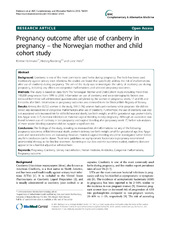| dc.description.abstract | Background: Cranberry is one of the most commonly used herbs during pregnancy. The herb has been used traditionally against urinary tract infections. No studies are found that specifically address the risk of malformations after use of cranberry during pregnancy. The aim of the study was to investigate the safety of cranberry use during pregnancy, including any effects on congenital malformations and selected pregnancy outcomes. Methods: The study is based on data from The Norwegian Mother and Child Cohort Study including more than 100,000 pregnancies from 1999 to 2008. Information on use of cranberry and socio-demographic factors was retrieved from three self-administered questionnaires completed by the women in pregnancy weeks 17 and 30, and 6 months after birth. Information on pregnancy outcomes was retrieved from the Medical Birth Registry of Norway. Results: Among the 68,522 women in the study, 919 (1.3%) women had used cranberry while pregnant. We did not detect any increased risk of congenital malformations after use of cranberry. Furthermore, the use of cranberry was also not associated with increased risk for stillbirth/neonatal death, low birth weight, small for gestational age, preterm birth, low Apgar score (<7), neonatal infections or maternal vaginal bleeding in early pregnancy. Although an association was found between use of cranberry in late pregnancy and vaginal bleeding after pregnancy week 17, further sub-analyses of more severe bleeding outcomes did not support a significant risk. Conclusions: The findings of this study, revealing no increased risk of malformations nor any of the following pregnancy outcomes; stillbirth/neonatal death, preterm delivery, low birth weight, small for gestational age, low Apgar score and neonatal infections are reassuring. However, maternal vaginal bleeding should be investigated further before any firm conclusion can be drawn. Treatment guidelines on asymptomatic bacteriuria in pregnancy recommend antimicrobial therapy as the first line treatment. According to our data and the outcomes studied, cranberry does not appear to be a harmful adjunctive self-treatment. | en_US |

